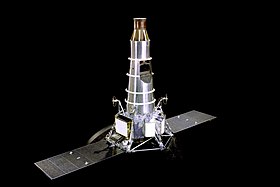 Ranger 9 | |||||
| Mission type | Lunar impactor | ||||
|---|---|---|---|---|---|
| Operator | NASA | ||||
| COSPAR ID | 1965-023A | ||||
| SATCAT no. | 1294 | ||||
| Mission duration | 2 days, 16 hours, 31 minutes | ||||
| Spacecraft properties | |||||
| Manufacturer | Jet Propulsion Laboratory | ||||
| Launch mass | 366.87 kg[1] | ||||
| Power | 200 W | ||||
| Start of mission | |||||
| Launch date | 21 March 1965, 21:37:02 UTC[1] | ||||
| Rocket | Atlas LV-3 Agena-B 204D/AA14 | ||||
| Launch site | Cape Canaveral LC-12 | ||||
| Lunar impactor | |||||
| Impact date | 24 March 1965, 14:08:19.994 UTC | ||||
| Impact site | 12°50′S 2°22′W / 12.83°S 02.37°W (Alphonsus crater) | ||||
| |||||
Ranger 9 was a Lunar probe, launched in 1965 by NASA. It was designed to achieve a lunar impact trajectory and to transmit high-resolution photographs of the lunar surface during the final minutes of flight up to impact. The spacecraft carried six television vidicon cameras—two wide-angle (channel F, cameras A and B) and four narrow-angle (channel P)—to accomplish these objectives. The cameras were arranged in two separate chains, or channels, each self-contained with separate power supplies, timers, and transmitters so as to afford the greatest reliability and probability of obtaining high-quality television pictures. These images were broadcast live on television to millions of viewers across the United States.[2] No other experiments were carried on the spacecraft.[3]
- ^ a b "Ranger 9". NASA's Solar System Exploration website. Retrieved December 1, 2022.
- ^ Cecil, Gregory (21 March 2015). "Our SpaceFlight Heritage: 50 Years since the launch of Ranger 9". Spaceflight Insider.
- ^ "Ranger 9". National Space Science Data Center. NASA. Retrieved 24 May 2012.